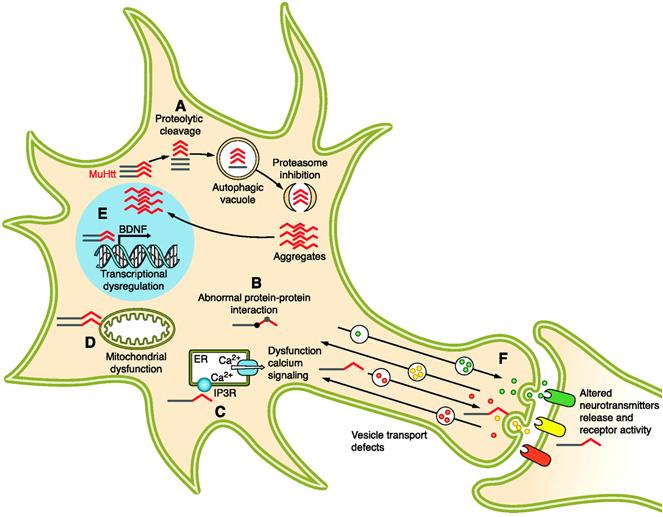File:Key cellular pathogenic mechanisms in Huntington's disease.jpg
Key_cellular_pathogenic_mechanisms_in_Huntington's_disease.jpg (663 × 517 pixels, file size: 47 KB, MIME type: image/jpeg)
Key cellular pathogenic mechanisms in Huntington's disease (HD). Multiple cellular pathways have been implicated in the pathogenesis of HD. These mechanisms could be exclusive or, more likely, have a high degree of cross-talk. A: the mutation in huntingtin causes a conformational change of the protein that leads to partial unfolding or abnormal folding of the protein, which can be corrected by molecular chaperones. Full-length mutant huntingtin is cleaved by proteases in the cytoplasm. In an attempt to eliminate the toxic huntingtin, fragments are ubiquitinated and targeted to the proteasome for degradation. However, the proteasome becomes less efficient in HD. Induction of the proteasome activity as well as of autophagy protects against the toxic insults of mutant huntingtin proteins by enhancing its clearance. B: NH2-terminal fragments containing the polyQ strech accumulate in the cell cytoplasm and interact with several proteins causing impairment of calcium signaling and homeostasis (C) and mitochondrial dysfunction (D). E: NH2-terminal mutant huntingtin fragments translocate to the nucleus where they impair gene transcription or form intranuclear inclusions. F: the mutation in huntingtin alters vesicular transport and recycling. muHtt, mutant huntingtin.
Reference
Zuccato C, Valenza M & Cattaneo E. (2010). Molecular mechanisms and potential therapeutical targets in Huntington's disease. Physiol. Rev. , 90, 905-81. PMID: 20664076 DOI.
http://physrev.physiology.org/content/90/3/905.full
Image URL: http://physrev.physiology.org/content/90/3/905/F3.expansion.html
Copyright Information
Organizations Requesting Permission to Reuse the Work of Others for Educational Purposes APS grants permission for free use of our articles (in whole or in part) in educational materials provided there is no charge or fee for those materials, and/or those materials are not directly or indirectly commercially supported. If a fee is charged or the materials are commercially supported, a fee will be assessed when permission is granted. Translation of a Figure or Table into another Language Figures and tables and (as well as relevant text legends) may be translated into another language, for reuse. Full citation and attribution for the English original is required, as well as a disclaimer regarding the completeness and accuracy of the translation. Full article translations may require a licensing contract.
Assessment
+ Image is very relevant to group topic. + Figure includes explanation with some peer teaching component, but you have not attempted to describe in your own words, just the original legend. + Copyright, citation and student disclaimer included.
- Note - This image was originally uploaded as part of a student project and may contain inaccuracies in either description or acknowledgements. Students have been advised in writing concerning the reuse of content and may accidentally have misunderstood the original terms of use. If image reuse on this non-commercial educational site infringes your existing copyright, please contact the site editor for immediate removal.
Cite this page: Hill, M.A. (2024, April 25) Embryology Key cellular pathogenic mechanisms in Huntington's disease.jpg. Retrieved from https://embryology.med.unsw.edu.au/embryology/index.php/File:Key_cellular_pathogenic_mechanisms_in_Huntington%27s_disease.jpg
- © Dr Mark Hill 2024, UNSW Embryology ISBN: 978 0 7334 2609 4 - UNSW CRICOS Provider Code No. 00098G
File history
Click on a date/time to view the file as it appeared at that time.
| Date/Time | Thumbnail | Dimensions | User | Comment | |
|---|---|---|---|---|---|
| current | 08:56, 13 October 2011 |  | 663 × 517 (47 KB) | Z3290270 (talk | contribs) | Key cellular pathogenic mechanisms in Huntington's disease (HD). Multiple cellular pathways have been implicated in the pathogenesis of HD. These mechanisms could be exclusive or, more likely, have a high degree of cross-talk. '''A:''' the mutation in hun |
You cannot overwrite this file.
File usage
The following file is a duplicate of this file (more details):
The following 2 pages use this file:
